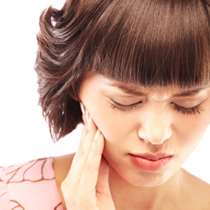Osteopathy & Dentistry
There is an important overlap between dentistry and osteopathy - especially cranial osteopathy. The relationship between the teeth and the body is complex, but from the osteopathic point of view, any dental issue has implications for the whole body, as the teeth are an important part of the body structure and the muscles of chewing are immensely powerful.
The upper teeth sit in the two maxillary bones which form the middle part of the face, the cheeks, while the lower teeth are in the mandible. The upper jaw is "fixed", so to speak, while the lower jaw can move around, because of the action of the temporo-mandibular joint (TMJ), which you can feel if you place your fingers just in front of your ear and open/close your mouth. The way that the teeth bite together (the bite, or occlusion) - the balance between the upper and lower jaw - plays an important part in the balance of the body as a whole.
The TMJ can become clicky and/or painful if either the bite or the body is out of balance. The effects can go either way: dental problems can put the TMJ out of balance, with knock-on effects on the body structure, or imbalances in the body structure can disturb the TMJ, in turn disturbing the bite.
TMJ dysfunction (TMD) can give rise to various symptoms including:
- Painful and/or clicky jaw
- Clenching and bruxism (grinding the teeth)
- Headaches, neck, shoulder or low back pain
- Ear problems, such as glue ear
- Tinnitus (ringing in the ears)
In fact, temporo-mandibular dysfunction and occlusal problems are quite common, and it is not always easy to distinguish whether the primary cause is in the bite or the body! Our osteopaths can help to discover and treat the cause of dysfunction, and you may want to seek an osteopathic assessment before embarking on orthodontic or surgical intervention. This is especially important if your child has been offered orthodontic treatment.

